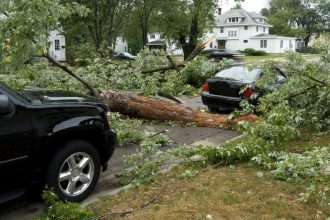Willie B. Thomas/ Getty Images; Illustration by Austin Courregé/Bankrate
Key takeaways
- Homeowners insurance can be costly, but there are several potential ways to save on premiums.
- Consider bundling your current car and home insurance policies, increasing your deductible or shopping around to find a better deal.
- Some providers also offer an assortment of discount opportunities to help you save even more money.
Most lenders require home insurance if you have a mortgage, but even if you own your home outright, insurance could offer valuable financial protection. Home insurance rates vary depending on several factors, such as where you live and the age of your home. Although those factors are outside your control, there are still steps you can take to potentially save on home insurance costs.
What factors affect your home insurance cost?
Understanding the factors insurers consider when calculating rates can point you in the right direction if you’re wondering how to lower homeowners insurance premiums:
- Age of your home: Older homes are typically more expensive to insure because they’re more susceptible to damage, but newer homes with expensive technology upgrades can also be costly to insure.
- Construction materials: Homes built with fire-resistant materials or compliant with modern construction standards may have lower premiums.
- Coverage amount: Your selected coverage types and limits will impact your rate. More robust coverage means a higher premium.
- Your deductible: In general, the higher your deductible, the lower your rate.
- Your credit history: Most states allow insurance providers to review your credit-based insurance score to determine the cost of your home insurance policy.
- Claims history: If you’ve filed home insurance claims in the past, insurers typically see you as more likely to file a future claim and raise your rates accordingly.
- Pets: Owning certain dog breeds that are considered high-risk can lead to higher premiums.
- Other factors: There are dozens of other insurance rating factors insurers use to set your rate. Marital status, attractive nuisances and distance from a fire station are a few.
How to lower home insurance costs
If you’re looking to save on homeowners insurance, here are just some of the things you can do.
Bundle your insurance policies
It’s not uncommon to have insurance with more than one provider. For example, your auto insurance may be with the same company you have been insured with since you were a young adult and you may have purchased your home insurance from a different provider when you bought your home.
However, bundling your home and auto insurance with one insurance company could save you significant money, as most insurers will give you a multi-policy discount to reward your loyalty. Ask your agent or insurance provider about multi-policy discounts to learn more.
Shop around
Each home insurance provider has its own guidelines and will set different prices for the same coverage types and limits. By shopping around, you can compare quotes from several providers to determine which can offer you the lowest premium.
If you are trying to capitalize on bundling savings to lower home insurance costs, consider cross-referencing your home insurance options with this list of car insurance providers to find companies that can offer you both.
Ask for discounts
Reach out to your current insurance provider to inquire about all its available home insurance discounts to help lower your homeowners insurance costs further. These could include:
- Discounts for safety measures: Something as simple as installing smart smoke detectors could save you money. Homeowners insurance providers also frequently offer discounts for home security systems, so consider investing in one to possibly lower your premiums.
- Loyalty discounts: If you have been with your insurer for a while and want to lower your premiums without switching, call and ask if they offer a loyalty discount.
- Payment discounts: Some insurance companies offer discounts for homeowners who use certain payment options or types, like those who choose to pay their premium in full or opt into auto-payments.
- New home or new buyer discounts: Some insurance providers offer discounts to first-time homebuyers or people who purchase newly constructed homes.
- Affiliation and military discounts: Current or former military members might be eligible for potential discounts. Your insurance provider might offer premium discounts for other professions, too, so ask an agent about possible affiliation discounts.
- Home improvement discount: Upgrading your home’s electrical, plumbing or heating systems may lower your insurance costs.
Learn more: Affordable home insurance companies
Evaluate your policy and increase your deductible
There are some parts of your home insurance that you are often required to have, such as:
Most insurance professionals would say that going without homeowners insurance is not worth the risk, but that does not mean you need to pay for excess coverage. You can talk to your provider or agent to see if there are optional coverage types included in your policy that are not a good fit for your needs.
You may also want to consider raising your deductible. This is the amount you pay out of pocket for a covered claim. If your deductible is $500, for example, and you have a covered claim worth $4,000, you will pay the first $500 of the claim and the insurance company will pay $3,500.
A higher deductible means you will pay more in the event of a claim, but it will also lower your premium. Keep in mind that raising your deductible means you are responsible for more money out of pocket if you file a claim, though. Be sure that you can afford a higher deductible before you make the change to your policy.
Improve your credit
Unless your home is in a state that prohibits insurers from using your credit-based insurance score to determine premiums, a low credit rating typically leads to a higher premium. This is because policyholders with poor credit histories are statistically more likely to file an insurance claim. If your credit score has recently improved, it may be worth reaching out to your insurance carrier to see if it could help your premium. If your credit score could still use some work, consider taking steps to improve it.
Keep your roof in good condition
A sturdy roof is one of the first defenses to protecting your family, your belongings and the structure of your home. To that end, the age and condition — and sometimes, even shape and materials — of your roof can be an important consideration for an insurance company when calculating homeowners insurance premiums. If your roof is too old or is in visibly poor condition, some companies may deny coverage. To keep your roof in good condition, it’s important to conduct regular inspections and perform repairs when necessary to help minimize the financial impact if a loss were to occur. Installing a new roof or retrofitting your existing roof to make it more resilient to storm damage may generate a premium reduction.
Learn more: Does home insurance cover roof replacement?
File claims sparingly
Deciding when to file a homeowners insurance claim is important. Filing a homeowners insurance claim can potentially increase your premiums in the future or even lead to a policy nonrenewal if you file multiple claims. Although filing a claim is necessary for any large covered losses, it is generally not advisable to file a claim for every small loss, especially if the cost to repair is under or close to your deductible limit. Furthermore, many insurance companies offer a claims-free discount, which would likely not be applied to a homeowners insurance policy if there is a history of small claims.
Frequently asked questions
-
-
In general, a standard homeowners insurance policy starts with six coverage options: dwelling amount, other structures, personal property, liability protection, medical payments and additional living expenses. From there, you can choose to include other optional coverage offered by your carrier. This could include scheduled personal property for any high-value items, identity theft, water backup and more.
-
Standard home insurance policies do not cover flood and earthquake damage. To have financial coverage against these loss types, a homeowner would need to purchase separate, standalone policies or endorsements. If you live in or near a flood zone, your lender may require a flood insurance policy in addition to a home insurance policy. Even if you don’t live in a flood zone, you may want to consider flood insurance as even a small amount of water can have devastating financial consequences. Flood insurance can be purchased through the federally-backed National Flood Insurance Program (NFIP) or private insurers. Earthquake insurance, on the other hand, isn’t usually a requirement, but homeowners living near an active fault line may want to consider purchasing coverage, which can typically be added as an endorsement to your home insurance. In California, earthquake coverage is offered through the California Earthquake Authority.
-
How much home insurance you need is based on several factors. As a starting point, you’ll want to gather information about the square footage of your home, the value of your personal belongings and any information on completed renovations and repairs. With this information, a licensed insurance agent will typically be able to help calculate the amount of dwelling coverage you need to repair or rebuild your home after a covered loss and ensure it’s in line with the cost of materials and labor in your area. You can also use this information as part of the process for getting a home insurance quote.
-
Unfortunately, paying off your mortgage doesn’t reduce homeowners insurance premiums. You will no longer be required to carry home insurance as it isn’t legally mandated, but your home will still require the same level of coverage to protect you from financial losses. In fact, if the cost to rebuild has gone up, you may need even more coverage.
-
Read the full article here














